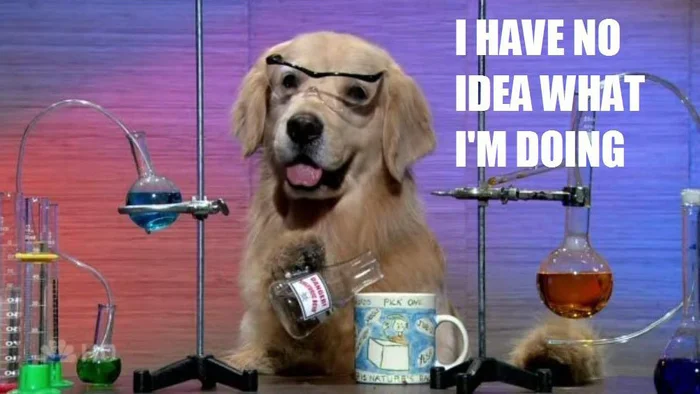Best-Laid Plans
The literature on thesauri is sparse, niche, and disparate. From the mid-70s through the early 90s (basically, from the spread of professional computing to the wider spread of the internet), there was a significant amount of conversation about thesaurus construction, but there has not been any literature that I am aware of that discusses revision to the various thesauri that were developed and put in use during that time. This might be partially attributable to the fact that many institutions may have just continually revised their thesauri since it was placed in used, but that has not been the case for the Kinsey Institute Library and Special Collections as we discussed.
All of this, as well as my post on information maintenance in general, is more or less me saying

*Image description: a golden retreiver (not a labradoodle) wearing science glasses is sitting behind a bench filled with scientific intruments. A caption reads ‘I HAVE NO IDEA WHAT I’M DOING’ but I suppose the puppy doesn’t look too put out by this fact. *
After a lot of thinking about the best ways to do this, here is the process I undertook—and I plan to describe it in further detail for my actual publication of course—:
Monthly Goals:
January
- Reviewing work already done on Sexual Nomenclature, a Thesaurus (SNT)—aka finding all the scholarly references to it & rereading Zhou and Drucker.
- Research & reading through vocabularies that are additionally relevant. Shoutout to Jay Colbert’s thesis here:
Colbert, J.L. “GLBT Controlled Vocabularies and Classification Schemes.” ALA, August 2017. http://www.ala.org/rt/sites/ala.org.rt/files/content/Accessibility/GLBT Controlled Vocabularies and Classification Schemes.pdf.
February
- Comparing new additions to the collections since the 1970’s and seeing what format gaps there were (largely in digital mediums, as I’ll discuss later).
- Reading, re-reading, re-re-re-reading (no joke, probably 4-6 times through).
- Coming up with 300 revisions, rejecting 150, negotiating them down to a reasonable number (both for my sake, the sake of those overseeing this, and because over time I began to understand things I saw as outdated language as more nuanced. Coming to respect and deeply admire the work of Brooks and Hoffer.)
March
March is the thesaurus-y month, breeding class hierarchies out of the MARC lands…
For a lot of reasons, this was a month I both want to linger over and also forget. We’re weeks past it and I can still not wrap my mind around everything that happened, the sickness, the stress.. but it was a busy month.
- Over the course of this month I began corrections in class hierarchy, BT, NT, RT’s to better reflect current understandings. Checking for issues with new terms added.
- The second half of the month I met with Director Zhou, Associate Director Wilson, my truly legendary 1 bosses to see what other terms might be added, and settled on the categories that I’ll discuss in the next post!
April
- Narrowing down the most needed term revisions and adjustments and writing it all up
- Proposal of an additional 30 terms from other controlled vocabularies such as Art, Psychology, etc.
- Revision of accepted, rejected, and modified changes into the electronic version of the thesaurus. Finalization, printing (?), archiving of new SNT
- Posting 12 different blog entries as a required part of my internship 🙃
&& here we are! Next time I’ll discuss some of the changes!
-
Honestly, though, this isn’t empty praise: exact Google Scholar / Google Book searches for Liana Zhou or Shawn Wilson pull up more effusive citations and credit than many academics will see their entire lives && they’re among the nicest, kindest and hardest working people I know. ↩︎